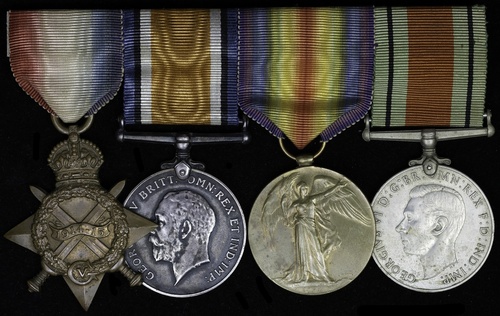
Auction: 25111 - Orders, Decorations and Medals - e-Auction
Lot: 490
The First and Second World Wars campaign group of four awarded to Gunner A. J. Lawrence, who served with the Calcutta Volunteer Battery in East Africa during the Great War
1914-15 Star (No. 1542 Gnr. A.J. Lawrence, 1 (C.P.D.) Group Garr. Arty. I.D.F.); British War Medal 1914-20 (1542 Gr. A.J. Lawrence. C.P.D.G.A. (A.F.); Victory Medal 1914-19 (1542 Gnr. A.J. Lawrence, Cal. Vol. Bty.); Defence Medal 1939-45, unnamed as issued, mounted for wear, very fine (4)
Arthur John Lawrence served in East Africa with the Calcutta Volunteer Battery from 3 October 1914; the unit (comprising six 12-pounder, 6-cwt field guns) sailed from India with Indian Expeditionary Force 'B' and perhaps the best account of their services and experiences can be found in a contemporary report from 'The Straits Times' of 5 December 1916:
'Calcutta Contingent.
Splendid Services in East Africa.
Nearly twenty-seven months ago a Volunteer Battery was formed in Calcutta for service in British East Africa. The Battery, which was designated the Calcutta Volunteer Battery, was composed of members of the Calcutta Port Defence Volunteers and the Cossipore Artillery Volunteers. About a month after its formation - in September, 1914 - the Battery numbering one hundred and ten strong, including officers, left for Bombay en route to East Africa. The men enlisted for a period of two years and saw a good deal of active service. The Battery distinguished itself and one of its members won the Distinguished Conduct Medal while no less than five others, among them two officers, were mentioned in despatches. At the expiration of the period for which they enlisted the men were detained for a couple of months longer as it was feared that their services would still be required. Fortunately, however, they were not needed any longer and the majority of them left East Africa for India, arriving in Calcutta on November 11.
The returning party comprised seven non-commissioned officers and fifty-six men, or a total of sixty-three in all. It was generally anticipated that the men would have been dismissed at the station but the military authorities decided that they would have to go to Fort William for that purpose. After all the kit of the party had been collected and packed on carts, the men fell in on the roadway opposite No.1 platform when the roll call was taken. Fours were then formed, and followed by a procession of motor cars, private conveyances and hackney carriages, the men marched across the Howrah Bridge and along Strand Road, entering the Fort by the Calcutta Gate. After once more answering to the roll call at the Fort, the men were dismissed.
Services in East Africa
Interviewed by a representative of the Englishman, some of the members stated that the Battery left Calcutta on September 14, 1914, and landed in British East Africa on October 3, 1914, and were immediately sent to the front. The Battery was divided into three sections, one section being sent to Tavoi and the other two sections to Nairobi. The Battery saw a good deal of active service and took part in various engagements. The main engagements were at Salita Hill and Latema Nek. The Battery bombarded Salita Hill no less than three times. The Battery also marched on Mikocheni, Luki Gora and Dahawa but did not come into action at these three places.
That the Battery distinguished itself is evidenced by the fact that Corporal Sievwright of the Cossipore Artillery Volunteers was awarded the Distinguished Conduct Medal. In addition Major Kinloch of the Cossipore Artillery Volunteers, Second Lieutenant Browning, Corporal Binning and Bombardier Emeny - all of the Calcutta Port Defence Volunteers - and Gunner Tocher of the Cossipore Artillery Volunteers, were mentioned in despatches. The Battery was singularly fortunate in that its casualties were exceptionally light. One man was killed and four men were wounded.
During the period they were in the field the men did a large amount of treking. It is estimated that in all they treked over one thousand miles. The difficulties that they had to encounter were well nigh insurmoutable. As the enemy held the main roads, the Battery had to execute flanking movements. The result was that they had to cut their way through dense jungle and make their own roads as they advanced. There was plenty of hard marching and eventually the Battery went as far south as Marogoro.
As the lines of communication were very long, the rations at times fell short. On the whole, however, considering the lengthy communications and the difficult country to be traversed, there was nothing to complain of as regards the food supply.
Disabled Enemy Gun
After the action at Latema Nek, a disabled six-inch gun was found in the zone of fire of the Battery. Naturally the Battery claimed the gun but although the authorities admitted that the gun in question was most probably put out of action by the Calcutta Volunteer Battery it was not made over to the Battery.
At the expiration of the period for which they enlisted, only some men of the original Battery rejoined. Several others being what is known as "draft" men had no option but to re-enlist. Nineteen members of the original Battery obtained commissions and are now stationed somewhere in East Africa.
The two diseases prevalent in East Africa are malaria and dysentery, and every man, without exception, suffered from these distressing complaints. As a matter of fact some men contracted these diseases no less than fifteen or twenty times.
Plenty of game of all kinds was come across by the men and several shikar parties were organised. At one period when the Battery was passing across the Kapiti plain the men occupied the only water holes in the district. Towards evening the animals came for their last drink and it was estimated that at one time there must have been thousands of different kinds of deer, gnu and zebras within rifle range. Shikaris were well to the fore and a large amount of eatable game was knocked over.
On another occasion the Battery came across no less than seven lions. The animals were so close that one of the noncommissioned officers fired at them with his revolver but, needless to say, without result. However, these lions were hunted the next day by some planters who shot the whole lot. While in garrison at Kim it was quite a common occurrence to come across rhinoceros during patrols every day. One day the men came across two ostrich nests. One contained fifty-five eggs and the other eighteen eggs. Omelettes and scrambled eggs varied the menu of the Battery for some days. The eggs were strong in flavour but the men got accustomed to the taste.'
Subject to 20% VAT on Buyer’s Premium. For more information please view Terms and Conditions for Buyers.
Sold for
£130
Starting price
£110




